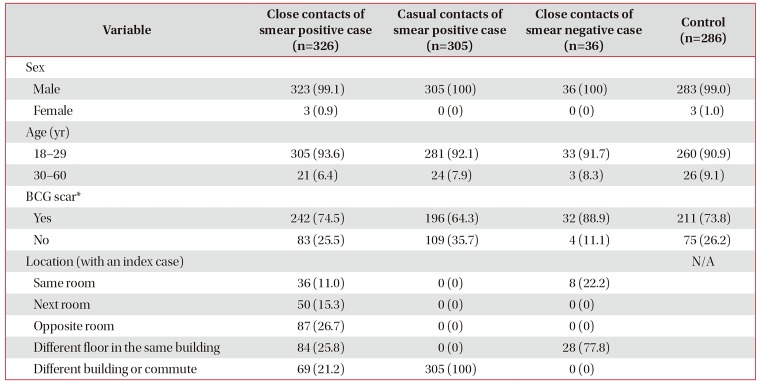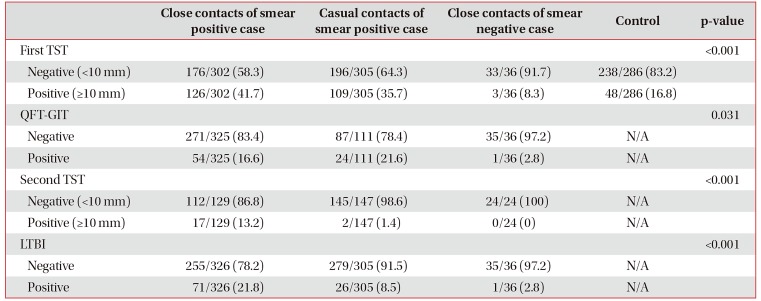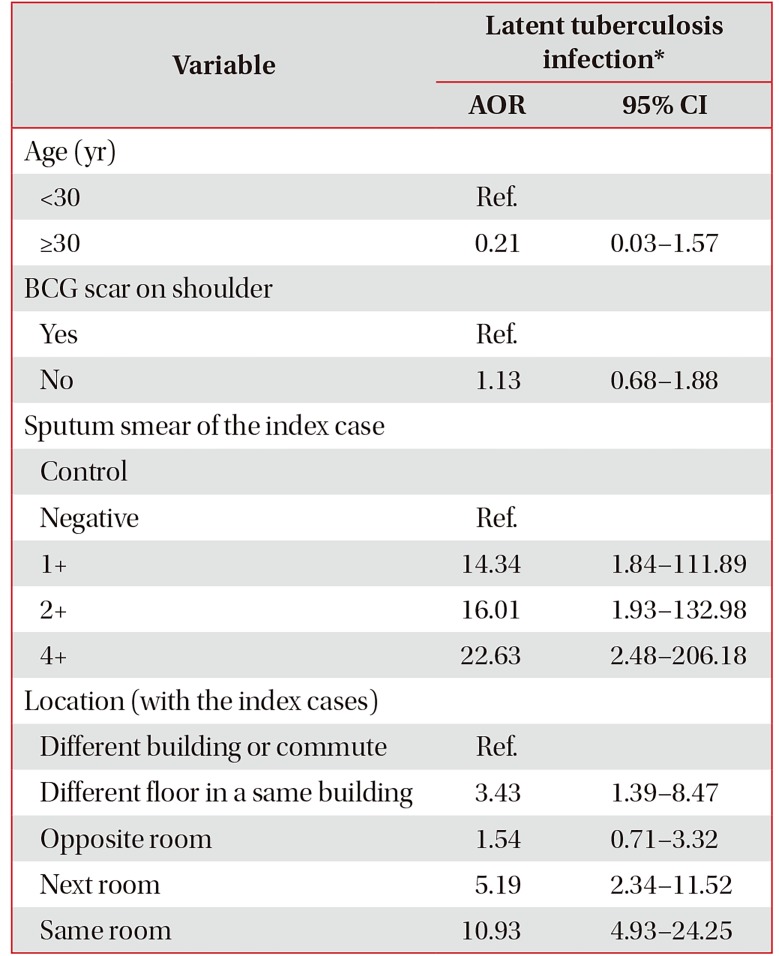1. Korea Centers for Disease Control and Prevention. 2017 Annual report on the notified tuberculosis in Korea. Cheongju: Korea Centers for Disease Control and Prevention;2018.
2. Statistics Korea. Causes of death statistics in 2015. Daejeon: Statistics Korea;2016.
3. Korea Centers for Disease Control and Prevention. National Tuberculosis Control Program Guideline. Cheongju: Korea Centers for Disease Control and Prevention;2018.
4. Kim SJ, Bai GH, Lee H, Kim HJ, Lew WJ, Park YK, et al. Transmission of
Mycobacterium tuberculosis among high school students in Korea. Int J Tuberc Lung Dis. 2001; 5:824–830. PMID:
11573893.
5. Yoon CG, Oh SY, Lee JB, Kim MH, Seo Y, Yang J, et al. Occupational risk of latent tuberculosis infection in health workers of 14 military hospitals. J Korean Med Sci. 2017; 32:1251–1257. PMID:
28665059.

6. Park JS. The prevalence and risk factors of latent tuberculosis infection among health care workers working in a tertiary hospital in South Korea. Tuberc Respir Dis. 2018; 81:274–280.

7. Kang CI, Choi CM, Kim DH, Kim CH, Lee DJ, Kim HB, et al. Pulmonary tuberculosis in young Korean soldiers: incidence, drug resistance and treatment outcomes. Int J Tuberc Lung Dis. 2006; 10:970–974. PMID:
16964786.
8. Lin JC, Lin TY, Perng WC, Mai CS, Chen YH, Ku CH, et al. An outbreak of tuberculosis in a bacillus Calmette-guerin-vaccinated military population. Mil Med. 2008; 173:388–392. PMID:
18472630.
9. Lee SW, Jang YS, Park CM, Kang HY, Koh WJ, Yim JJ, et al. The role of chest CT scanning in TB outbreak investigation. Chest. 2010; 137:1057–1064. PMID:
19880906.

10. Lee SW, Jeon K, Kim KH, Min KH. Multidrug-resistant pulmonary tuberculosis among young Korean soldiers in a communal setting. J Korean Med Sci. 2009; 24:592–595. PMID:
19654938.

11. Choi CM, Hwang SS, Lee CH, Lee HW, Kang CI, Kim CH, et al. Latent tuberculosis infection in a military setting diagnosed by whole-blood interferon-gamma assay. Respirology. 2007; 12:898–901. PMID:
17986121.
12. Choi CM, Kang CI, Jeung WK, Kim DH, Lee CH, Yim JJ. Role of the C-reactive protein for the diagnosis of TB among military personnel in South Korea. Int J Tuberc Lung Dis. 2007; 11:233–236. PMID:
17263297.
13. Yoon H, Jhun BW, Kim SJ, Kim K. Clinical characteristics and factors predicting respiratory failure in adenovirus pneumonia. Respirology. 2016; 21:1243–1250. PMID:
27301912.

14. Yoo H, Gu SH, Jung J, Song DH, Yoon C, Hong DJ, et al. Febrile respiratory illness associated with human adenovirus type 55 in South Korea Military, 2014–2016. Emerg Infect Dis. 2017; 23:1016–1020. PMID:
28518038.
15. Ministry of National Defense. Korea Centers for Disease Control and Prevention. Military tuberculosis control manual. Cheongju: Korea Centers for Diseases Control and Prevention;2012.
16. Choi CM, Kang CI, Kim DH, Kim CH, Kim HJ, Lee CH, et al. The role of TST in the diagnosis of latent tuberculosis infection among military personnel in South Korea. Int J Tuberc Lung Dis. 2006; 10:1342–1346. PMID:
17167950.
17. Kwon Y, Kim SJ, Kim J, Kim SY, Song EM, Lee EJ, et al. Results of tuberculosis contact investigation in congregate settings in Korea, 2013. Osong Public Health Res Perspect. 2014; 5(Suppl):S30–S36. PMID:
25861578.

18. Mazurek GH, Jereb J, Vernon A, LoBue P, Goldberg S, Castro K, et al. Updated guidelines for using interferon gamma release assays to detect Mycobacterium tuberculosis infection: United States, 2010. MMWR Recomm Rep. 2010; 59:1–25.
19. Ji SH, Kim HJ, Choi CM. Management of tuberculosis outbreak in a small military unit following the Korean National Guideline. Tuberc Respir Dis. 2007; 62:5–10.

20. Lee SW, Oh SY, Lee JB, Choi CM, Kim HJ. Tuberculin skin test distribution following a change in BCG vaccination policy. PLoS One. 2014; 9:e86419. PMID:
24466082.

21. Kak V. Infections in confined spaces: cruise ships, military barracks, and college dormitories. Infect Dis Clin North Am. 2007; 21:773–784. PMID:
17826623.

22. Lamar JE 2nd, Malakooti MA. Tuberculosis outbreak investigation of a U.S. Navy amphibious ship crew and the Marine expeditionary unit aboard, 1998. Mil Med. 2003; 168:523–527. PMID:
12901459.

23. Foote FO. A tuberculosis event on a Navy assault ship. Mil Med. 2006; 171:1198–1200. PMID:
17256682.
24. Kipfer B, Reichmuth M, Buchler M, Meisels C, Bodmer T. Tuberculosis in a Swiss army training camp: contact investigation using an interferon gamma release assay. Swiss Med Wkly. 2008; 138:267–272. PMID:
18481233.
25. Fujikawa A, Fujii T, Mimura S, Takahashi R, Sakai M, Suzuki S, et al. Tuberculosis contact investigation using interferongamma release assay with chest x-ray and computed tomography. PLoS One. 2014; 9:e85612. PMID:
24454900.

26. Choi Y, Jeong GH. Army soldiers' knowledge of, attitude towards, and preventive behavior towards tuberculosis in Korea. Osong Public Health Res Perspect. 2018; 9:269–277. PMID:
30402383.










 PDF
PDF ePub
ePub Citation
Citation Print
Print



 XML Download
XML Download